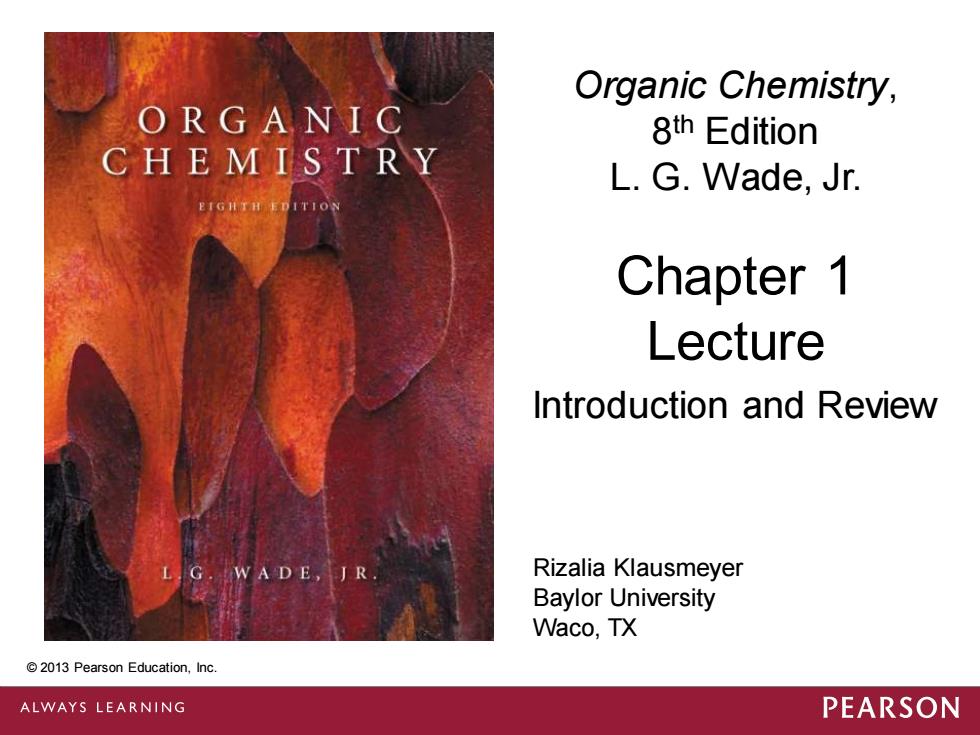
Organic Chemistry, ORGANIC 8th Edition CHEMISTRY L.G.Wade,Jr. ETGH下E Chapter 1 Lecture Introduction and Review .WAD E.JR Rizalia Klausmeyer Baylor University Waco,TX 2013 Pearson Education,Inc. ALWAYS LEARNING PEARSON
© 2013 Pearson Education, Inc. Chapter 1 Lecture Organic Chemistry, 8 th Edition L. G. Wade, Jr. Introduction and Review © 2013 Pearson Education, Inc. Rizalia Klausmeyer Baylor University Waco, TX
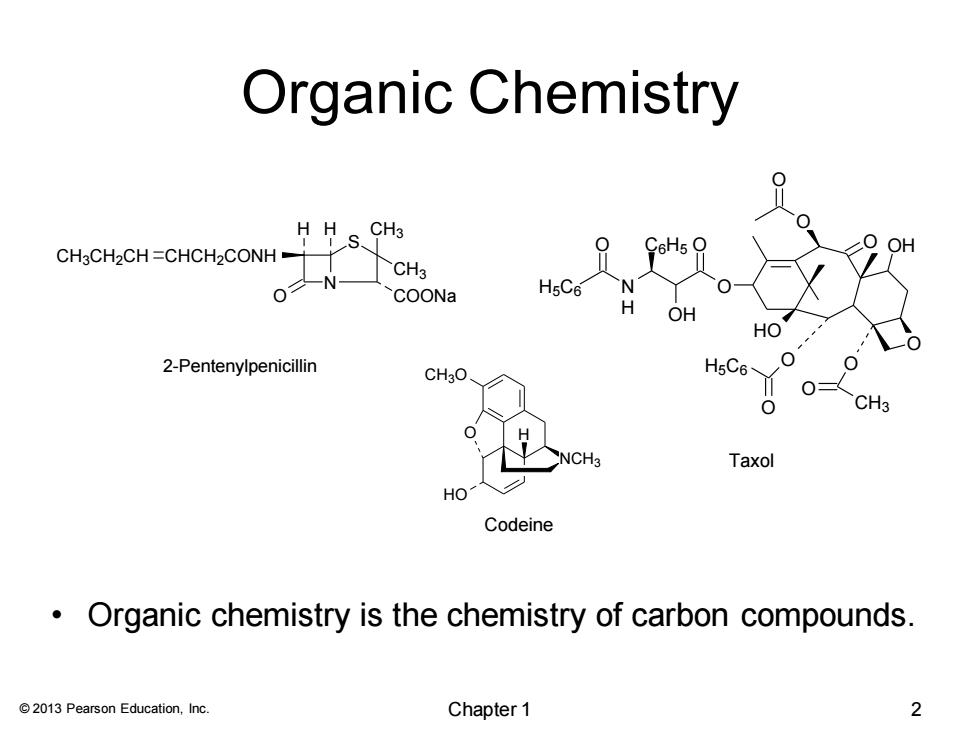
Organic Chemistry H HS.CHa CH3CH2CH =CHCH2CONH- C6H5 O CH3 COONa H5C6 N H OH HO 2-Pentenylpenicillin CH3O H5C6. CH3 NCH3 Taxol HO Codeine Organic chemistry is the chemistry of carbon compounds. 2013 Pearson Education,Inc. Chapter 1 2
© 2013 Pearson Education, Inc. Chapter 1 2 Organic Chemistry • Organic chemistry is the chemistry of carbon compounds. H5C6 N H O O C6H5 OH O O O O OH O O O CH3 O O H5C6 HO Taxol O CH3O H NCH3 HO Codeine 2-Pentenylpenicillin N S CHCH2CONH H H O CH3 CH3 COONa CH3CH2CH
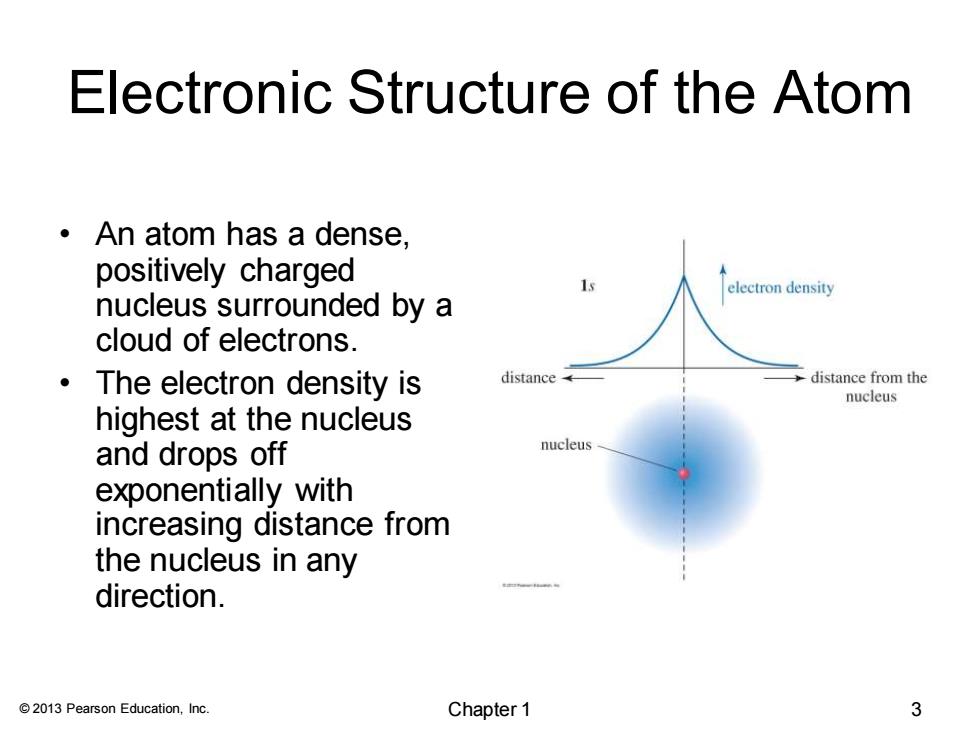
Electronic Structure of the Atom ·An atom has a dense, positively charged electron density nucleus surrounded by a cloud of electrons. The electron density is distance distance from the nucleus highest at the nucleus and drops off nucleus exponentially with increasing distance from the nucleus in any direction. 2013 Pearson Education,Inc. Chapter 1 3
© 2013 Pearson Education, Inc. Chapter 1 3 Electronic Structure of the Atom • An atom has a dense, positively charged nucleus surrounded by a cloud of electrons. • The electron density is highest at the nucleus and drops off exponentially with increasing distance from the nucleus in any direction
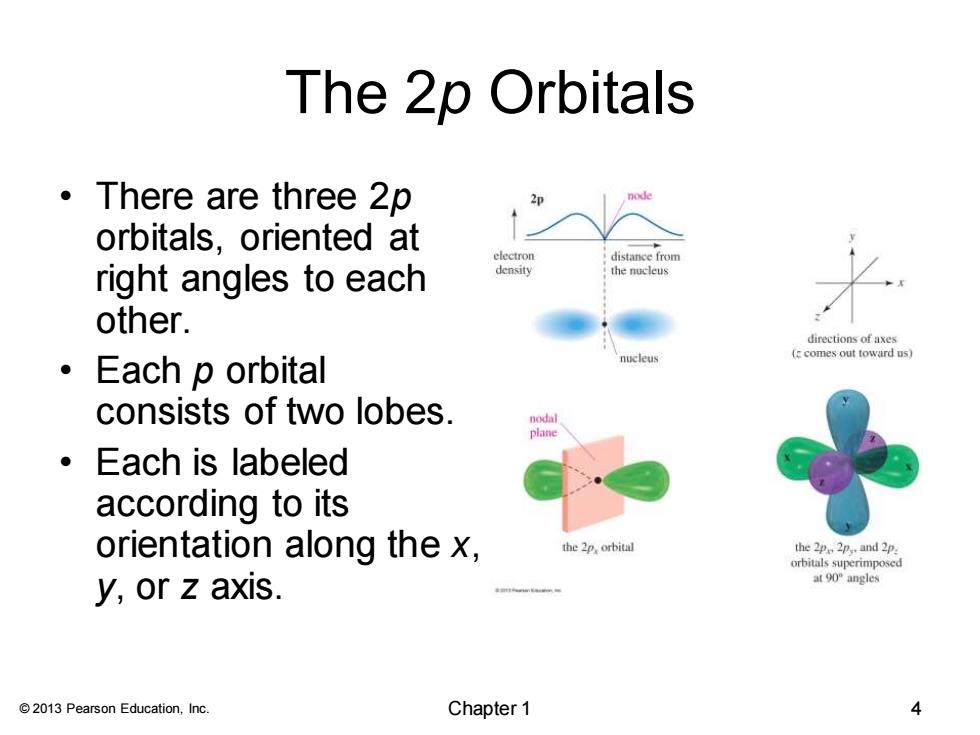
The 2p Orbitals ·There are three2p orbitals,oriented at distance fron right angles to each the nucleus other. directions of axes (z comes out toward us) ·Each p orbital consists of two lobes nodal 。 Each is labeled according to its orientation along the x, the 2p,orbital the 2p 2p.and 2p. orbitals superimposed y,or z axis. a90°angles 2013 Pearson Education,Inc. Chapter 1 4
© 2013 Pearson Education, Inc. The 2p Orbitals • There are three 2p orbitals, oriented at right angles to each other. • Each p orbital consists of two lobes. • Each is labeled according to its orientation along the x, y, or z axis. Chapter 1 4
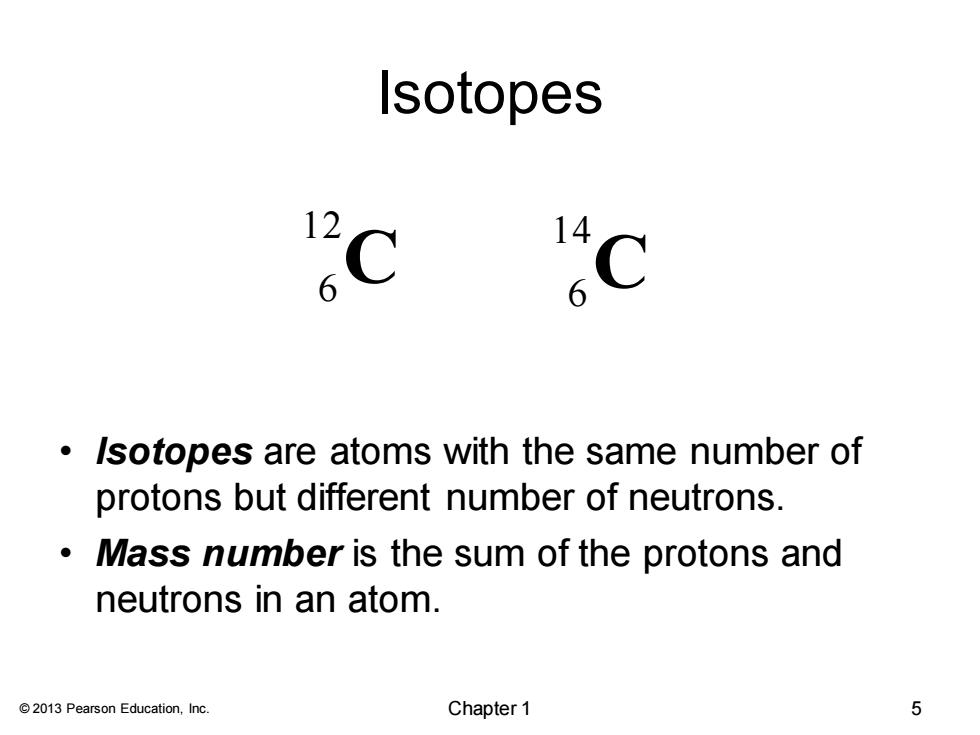
Isotopes 2 6 Isotopes are atoms with the same number of protons but different number of neutrons. Mass number is the sum of the protons and neutrons in an atom. 2013 Pearson Education,Inc. Chapter 1 5
© 2013 Pearson Education, Inc. Isotopes • Isotopes are atoms with the same number of protons but different number of neutrons. • Mass number is the sum of the protons and neutrons in an atom. C 1 2 6 6 C 1 4 Chapter 1 5
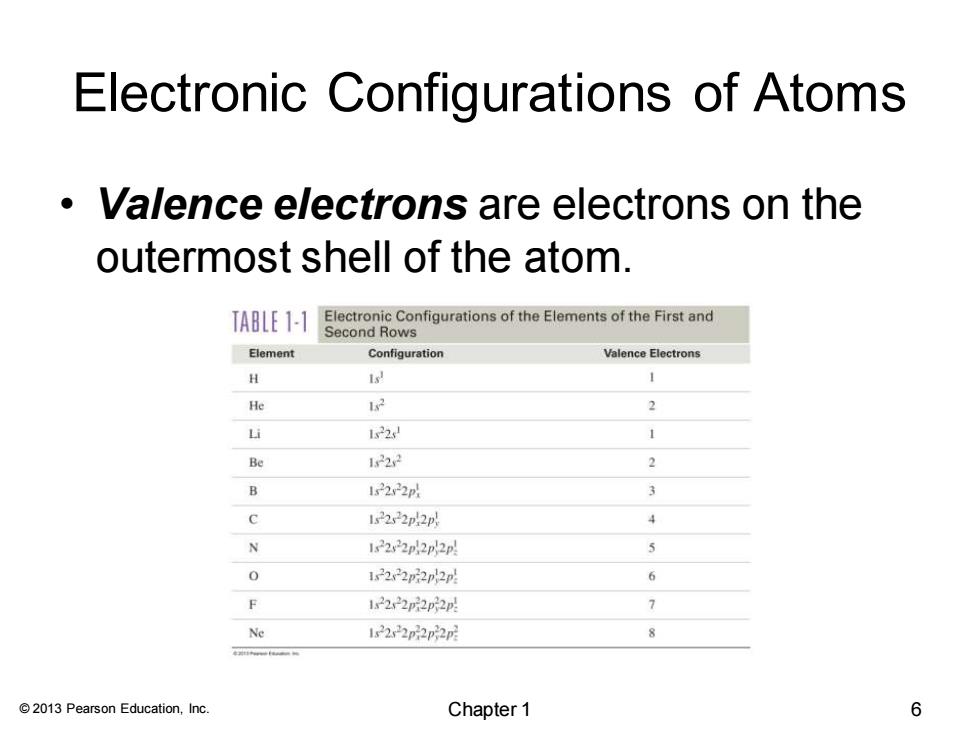
Electronic Configurations of Atoms Valence electrons are electrons on the outermost shell of the atom. ecronc Configurations of the Elements of the First and Second Rows Element Configuration Valence Electrons H He 2 2 山 122 Be 1222 B 12222p 3 1s22s22p2p N 12222p2p2n 0 122222 F 12222p2p2p月 Ne 12222p2 2013 Pearson Education,Inc. Chapter 1 6
© 2013 Pearson Education, Inc. Electronic Configurations of Atoms • Valence electrons are electrons on the outermost shell of the atom. Chapter 1 6
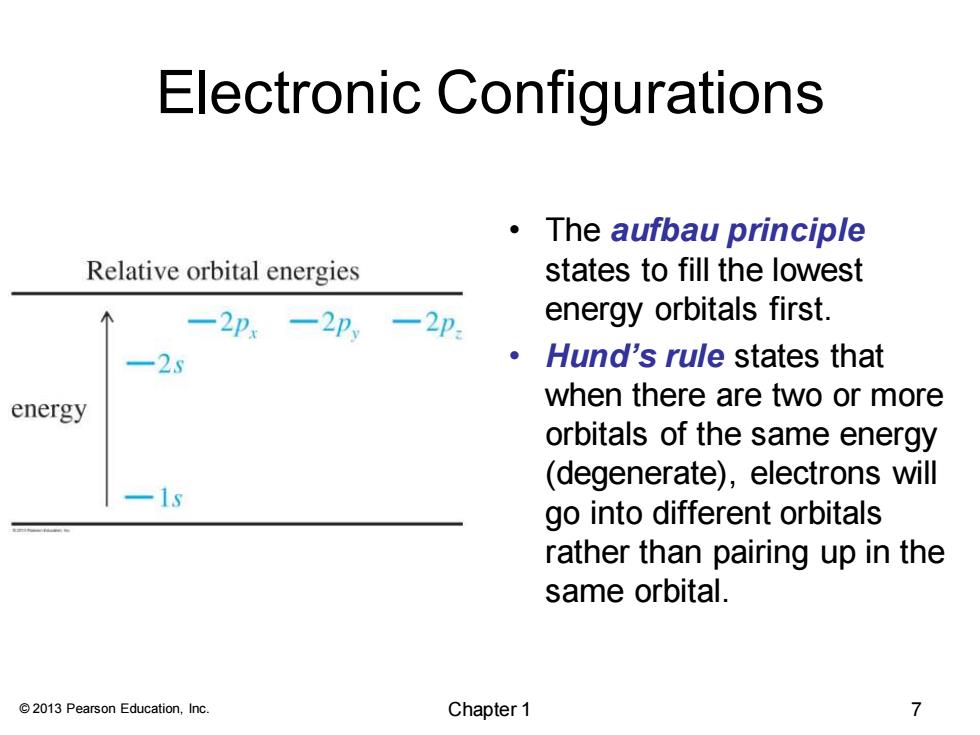
Electronic Configurations 。The aufbau principle Relative orbital energies states to fill the lowest 一2p,-2p一2p energy orbitals first -25 Hund's rule states that energy when there are two or more orbitals of the same energy (degenerate),electrons will -1s go into different orbitals rather than pairing up in the same orbital. 2013 Pearson Education,Inc. Chapter 1 7
© 2013 Pearson Education, Inc. Electronic Configurations • The aufbau principle states to fill the lowest energy orbitals first. • Hund’s rule states that when there are two or more orbitals of the same energy (degenerate), electrons will go into different orbitals rather than pairing up in the same orbital. Chapter 1 7
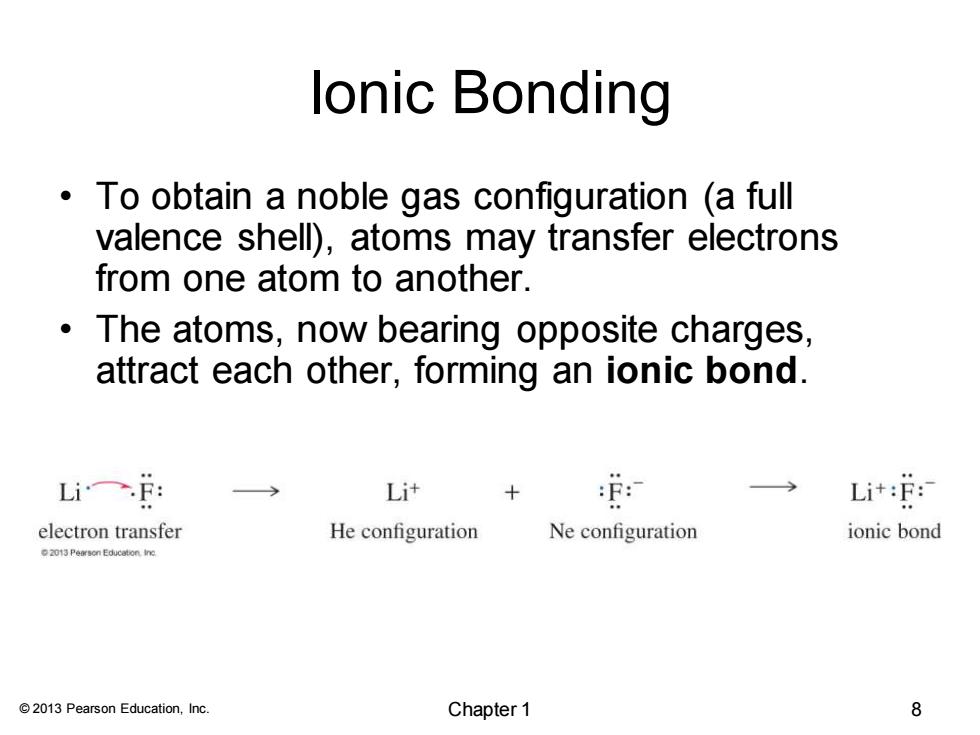
lonic Bonding To obtain a noble gas configuration (a full valence shell),atoms may transfer electrons from one atom to another. The atoms,now bearing opposite charges, attract each other,forming an ionic bond. Li一f: Li+ 浴、 Li+:F: electron transfer He configuration Ne configuration ionic bond 2013 Pearson Education.Ine 2013 Pearson Education,Inc. Chapter 1 8
© 2013 Pearson Education, Inc. Ionic Bonding • To obtain a noble gas configuration (a full valence shell), atoms may transfer electrons from one atom to another. • The atoms, now bearing opposite charges, attract each other, forming an ionic bond. Chapter 1 8

Covalent Bonding Electrons are shared between the atoms to complete the octet. When the electrons are shared evenly,the bond is said to be nonpolar covalent,or pure covalent. When electrons are not shared evenly between the atoms,the resulting bond will be polar covalent. H(:○H nonpolar polar covalent bond covalent bond D2013 Pearson Education.Ing 2013 Pearson Education,Inc. Chapter 1 9
© 2013 Pearson Education, Inc. Covalent Bonding • Electrons are shared between the atoms to complete the octet. • When the electrons are shared evenly, the bond is said to be nonpolar covalent, or pure covalent. • When electrons are not shared evenly between the atoms, the resulting bond will be polar covalent. Chapter 1 9
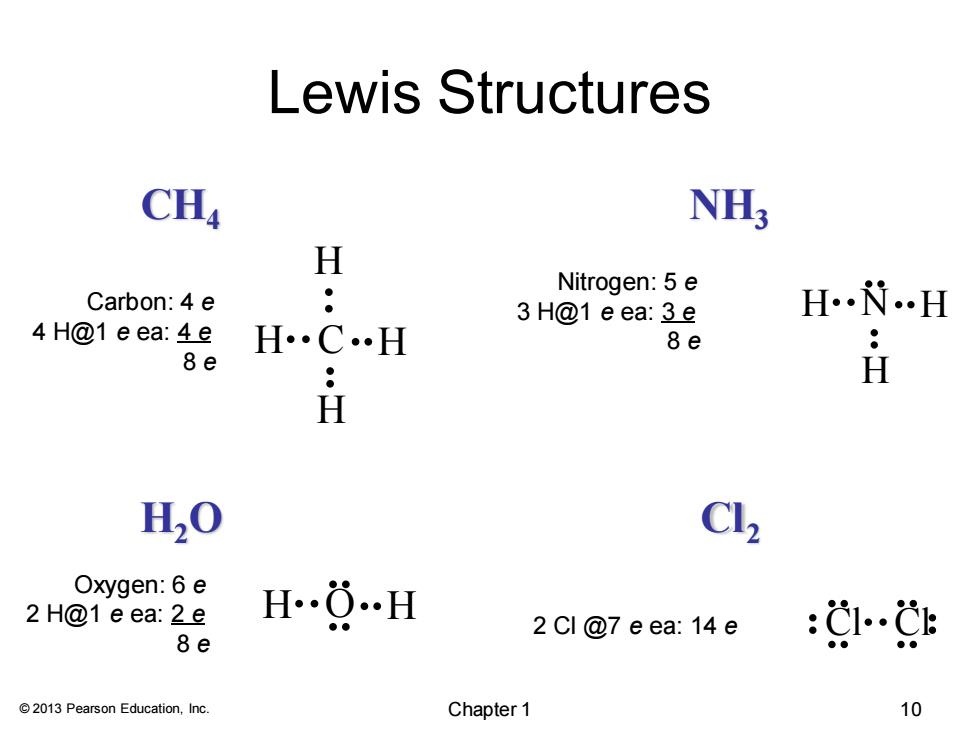
Lewis Structures CHa NH3 H Nitrogen:5 e Carbon:4 e 3 H@1 e ea:3e …H 4 H@1 e ea:4e H H 8e 8e H H20 Cl2 Oxygen:6 e 2 H@1 e ea:2e …0…H 2 Cl @7 e ea:14 e 8e :C1C 2013 Pearson Education,Inc. Chapter 1 10
© 2013 Pearson Education, Inc. CH4 NH3 H2O Cl2 Lewis Structures C H H H H N H H H H O H Cl Cl Carbon: 4 e 4 H@1 e ea: 4 e 8 e Nitrogen: 5 e 3 H@1 e ea: 3 e 8 e Oxygen: 6 e 2 H@1 e ea: 2 e 8 e 2 Cl @7 e ea: 14 e Chapter 1 10